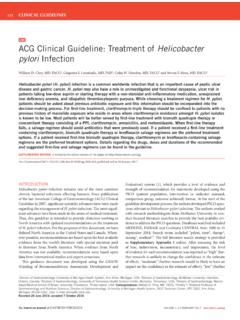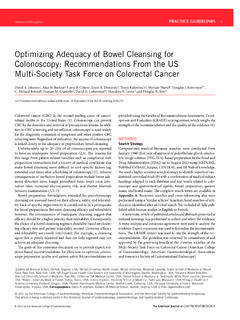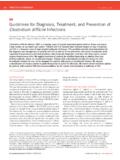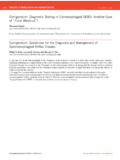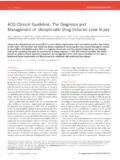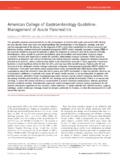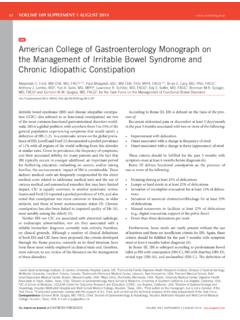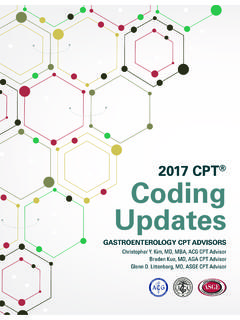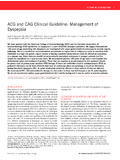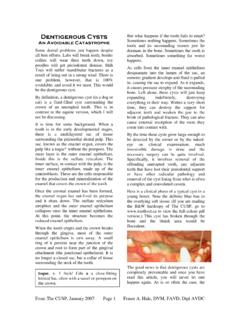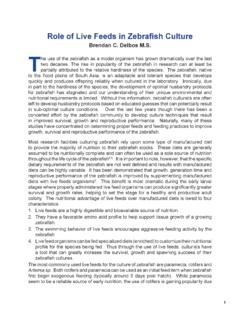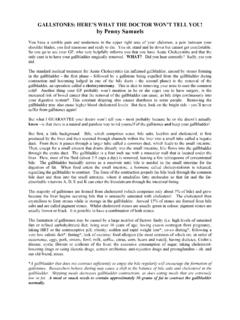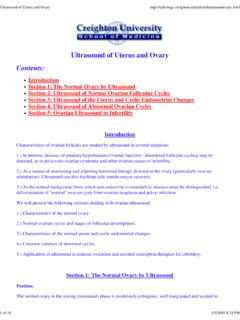Transcription of ACG Clinical Guideline: Diagnosis and Management …
1 1 2018 by the American College of Gastroenterology The American Journal of GASTROENTEROLOGYCLINICAL GUIDELINES INTRODUCTION Pancreatic cysts are oft en detected on abdominal imaging per-formed for non-pancreatic indications. Th eir prevalence in an asymptomatic population is reported from to with increasing incidence with age ( 1 ). A review of abdominal mag-netic resonance imaging (MRIs) performed for non-pancreatic indications in patients over the age of 70 showed a 40% incidence of incidental pancreatic cysts ( 2 ). Somewhat reassuring is the low prevalence of cysts >2 cm; in 25,195 subjects in fi ve studies the prevalence of cysts >2 cm was only ( 3 ).
2 Pancreatic cysts are increasingly being diagnosed because of the use of more abdomi-nal imaging and to the increased quality of that imaging. Th e overall incidence of pancreatic cancer-related mortality is fairly stable; thus, the increasing incidence of cysts is likely due to the increase in diagnostic scrutiny ( 4 ). Some pancreatic cysts have the potential for malignant transfor-mation to invasive ducal adenocarcinoma of the pancreas, hence the cause for concern. Th e exact risk of malignant transformation is unclear; however, when considering all individuals with pan-creatic cysts, the potential risk for malignant transformation is small ( 5 ).
3 Using the assumption that all pancreatic cancer arises in patients within pancreatic cysts, an analysis of the SEER database found the probability that a cyst harbors malignancy at the time of imaging is , with the overall conversion rate to invasive can-cer being per year ( 3 ). However, retrospective series of sur-gically resected cysts have reported higher rates, with the pooled proportion of cysts with pancreatic cancer of 15% in 27 studies of 2,796 patients ( 3 ). Th e approach of including all pancreatic cysts has been criticized, as many pancreatic cysts have no malig-nant potential ( 6,7 ). When only intraductal papillary mucinous neoplasms (IPMNs) are included, a review of 99 studies of 9,249 patients with IPMNs who underwent surgical resection found that the incidence of either high-grade dysplasia or pancreatic can-cer was 42% ( ref.)
4 3 ). Th e data evaluating the long-term risk of an IPMN developing pancreatic cancer are also contradictory. One review of 3,980 patients with suspected IPMNs reported an over-all risk of developing pancreatic cancer of (95% confi dence interval (CI), ), which was consistent with an estimated risk of developing pancreatic cancer of per year (95% CI, ) ( 3 ). In contrast, a recent systematic review and meta-analysis of 3,236 patients divided IPMNs into low and high risk, the latter being defi ned as the presence of a mural nodule or dilated main pancreatic duct. Th ey reported a pooled cumulative inci-dence of high-grade dysplasia or pancreatic cancer of (95% CI, ) at 1 year, (95% CI, ) at 5 years, and (95% CI, ) at 10 years for low-risk IPMNs.
5 Th e pooled cumulative incidence was (95% CI, ) at 1 year, (95% CI, ) at 5 years, and (95% CI, ) at 10 years for high-risk IPMNs ( 8 ). Large, pro-spective, multicenter studies following cysts that are presumed to be mucinous are required to answer the critical question of the cumulative risk of high-grade dysplasia or cancer. ACG Clinical Guideline: Diagnosis and Management of Pancreatic Cysts Grace H. Elta , MD, FACG 1 , Brintha K. Enestvedt , MD, MBA 2 , Bryan G. Sauer , MD, MSc, FACG (GRADE Methodologist) 3 a n d Anne Marie Lennon , MD, PhD, FACG 4 Pancreatic cysts are very common with the majority incidentally identifi ed.
6 There are several types of pancreatic cysts; some types can contain cancer or have malignant potential, whereas others are benign. However, even the types of cysts with malignant potential rarely progress to cancer. At the present time, the only viable treatment for pancreatic cysts is surgical excision, which is associated with a high morbidity and occasional mortality. The small risk of malignant transformation, the high risks of surgical treatment, and the lack of high-quality prospective studies have led to contradictory recommendations for their immediate Management and for their surveillance. This guideline will provide a practical approach to pancreatic cyst Management and recommendations for cyst surveillance for the general gastroenterologist.
7 Am J Gastroenterol advance online publication, 27 February 2018; doi: 1 Division of Gastroenterology, University of Michigan Medical Center , Ann Arbor , Michigan , USA ; 2 Division of Gastroenterology, Oregon Health and Sciences University , Portland , Oregon , USA ; 3 Division of Gastroenterology, University of Virginia , Charlottesville , Virginia , USA ; 4 Division of Gastroenterology, The Johns Hopkins Medical Institutions , Baltimore , Maryland , USA . Correspondence: Grace H. Elta, MD, FACG, Division of Gastroenterology, University of Michigan Medical Center , 3912 Taubman Center, Michigan Medicine , Ann Arbor , Michigan 48109-5362 , USA.
8 E-mail: Received 24 September 2017 ; accepted 5 January 2018 Elta et al. The American Journal of GASTROENTEROLOGY VOLUME XXX | XXX 2018 2 Management decisions for pancreatic cysts must take into account their low risk of malignancy vs. their frequent detec-tion. Th e cost of cyst analysis and cyst surveillance is high, and the benefi t in terms of cancer prevention is unproven. Th ere have been no dedicated cost eff ectiveness analyses about surveillance of incidental pancreatic cysts. Th e risks of pancreatic surgery are relatively high. A recent review of the literature suggests that the mortality rate from pancreatic resection for pancreatic cysts is with a morbidity rate of 30% ( 3 ).
9 Large worrisome cysts are more commonly found in elderly individuals with comorbidities. Individual life expectancy and risk of death from other factors must be carefully considered in analyzing the risks that pancreatic cysts pose. Th is guideline will review the various types of pancreatic cysts ( Ta b l e 1 ), address common Clinical questions regarding their Management , and provide guidance on when to refer for further evaluation by using a combination of a systematic review of the literature and expert recommendations ( Figure 1 ). Th e guideline does not apply to patients with strong family history of pancreatic cancer or genetic mutations known to predispose to pancreatic cancer.
10 TYPES OF PANCREATIC CYSTS Cystic lesions of the pancreas have a large diff erential Diagnosis ( Ta b l e 2 ). Th ey can be broadly categorized as neoplastic or non-neoplastic ( , pseudocysts) and as mucin-producing (IPMNs or mucinous cystic neoplasms (MCNs)) vs. non-mucin producing. Cystic lesions with malignant potential include IPMNs, MCNs, solid-pseudopapillary tumors, and pancreatic neuroendocrine tumors. Th e Diagnosis of cyst type relies on imaging characteristics and, for some cysts, on the analysis of cyst fl uid. Despite high-qual-ity imaging with computed tomography (CT), MRI, and cyst fl uid analysis, the correct classifi cation of cyst type can be challenging.
